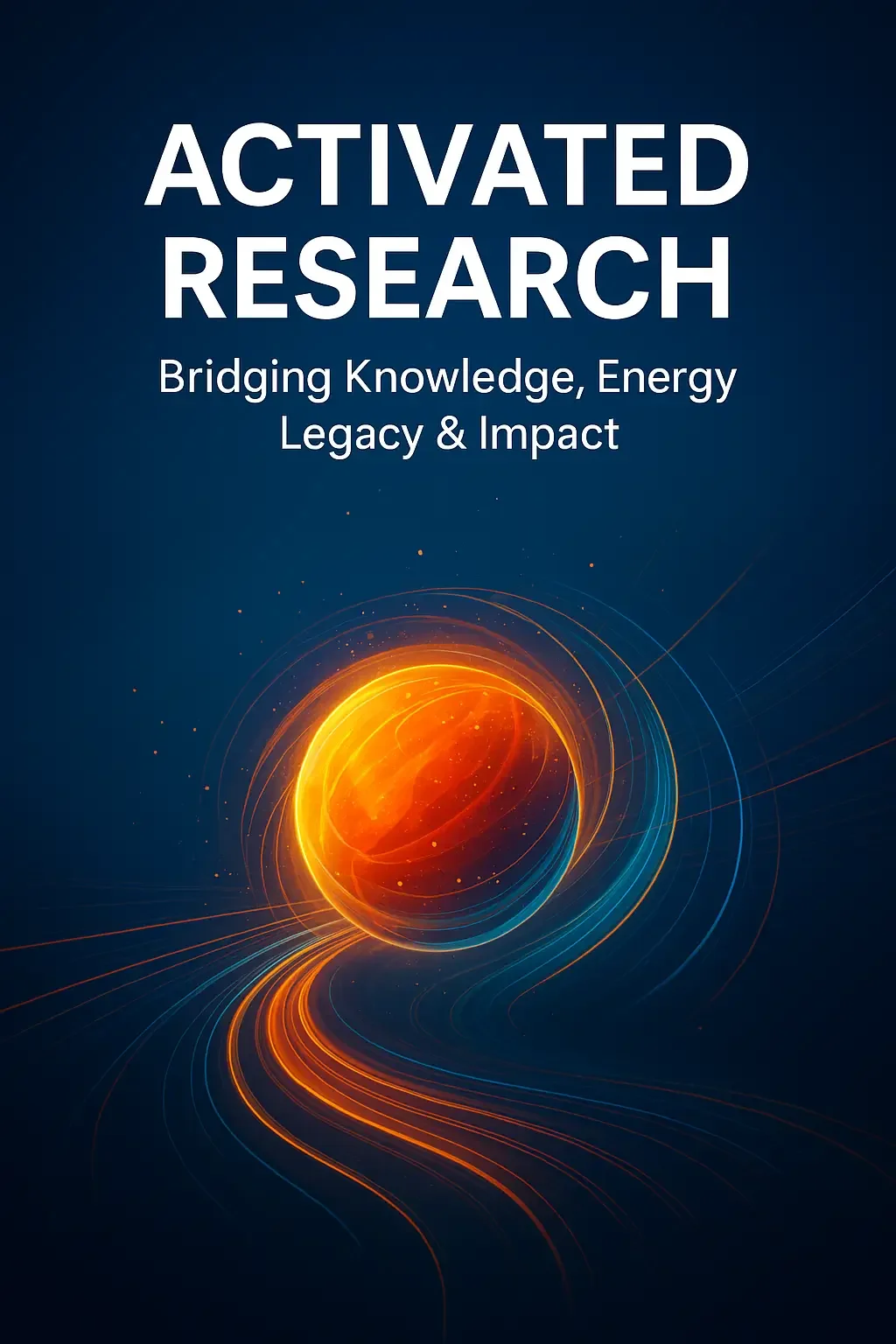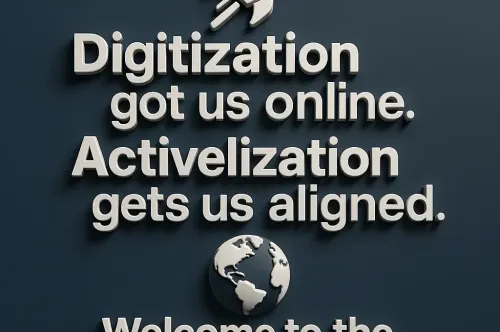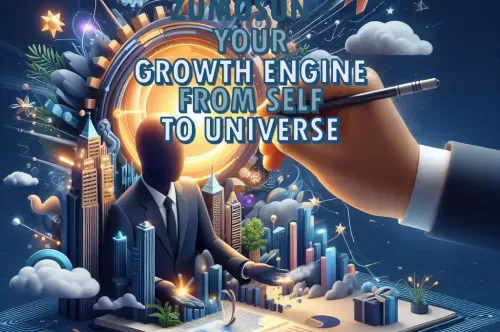Activated Research | Knowledge into Action

Activated Research and Its Applied Use: Transforming Knowledge into Civilizational Activation
Author: Prakash Chand Sharma
Founder, Zumosun Activated Universe & Civilization (AUC)
Scientist | Researcher | Futurist | Speaker
Abstract
Traditional research has long been the foundation of human knowledge, producing theories, discoveries, and technologies. However, it often remains limited to passive accumulation of information. This paper introduces Activated Research, a transformative framework from the Zumosun Activated Universe & Civilization (AUC) that converts knowledge into activated intelligence, systemic action, and civilizational evolution. Built on the PURE Equation and the principle of Zuositivity, Activated Research transcends conventional inquiry by aligning awareness, synergy, feedback, and purpose into actionable outcomes. This study explores its theoretical foundation, methodology, and applied uses across science, enterprise, governance, and cosmic civilization building.
“Learn more about the AUC vision for civilizational activation.”
1. Introduction
Research has always been the driving force of human progress. From the earliest astronomical observations by ancient civilizations to the breakthroughs of modern quantum physics and artificial intelligence, research has defined how humanity understands and navigates reality. At its core, research is the structured pursuit of knowledge: it observes, inquires, hypothesizes, tests, and explains. It produces scientific discoveries, technological inventions, cultural insights, and theoretical frameworks. Without it, civilization would stagnate.
Yet, despite its achievements, traditional research is fundamentally incomplete. It is often descriptive and analytical, not activating and transformative. Libraries are filled with research papers that are never applied. Scientific breakthroughs may remain trapped in academic silos for decades. Societal problems persist, not because we lack knowledge, but because we fail to activate it at scale. Knowledge without activation becomes inert — an untapped reservoir of human potential.
This problem creates what can be called the civilizational bottleneck. On one side lies the immense accumulation of human knowledge; on the other side lies the urgent need for systemic transformation in governance, enterprise, technology, environment, and social structures. Between them is a gap — the gap between knowing and activating. Bridging this gap is the mission of Activated Research.
1.1 From Research to Activated Research
Traditional research is concerned with what is. It explains reality, documents phenomena, and establishes causal relationships. Its success is measured by publications, citations, and theoretical advancements. While valuable, such metrics do not necessarily translate into civilizational outcomes.
Activated Research, as introduced within the framework of the Zumosun Activated Universe & Civilization (AUC), goes further. It is defined as:
“The energized, purpose-aligned, and action-driven process of inquiry that transforms knowledge into activated intelligence, systemic resonance, and meaningful outcomes, guided by the PURE Equation and Zuositivity.”
The key difference is activation. Knowledge is not considered complete until it is activated — translated into purposeful action, scaled into systems, and aligned with civilizational growth. Research becomes a dynamic engine, not merely a passive archive.
1.2 The PURE Equation as a Compass
At the foundation of Activated Research lies the PURE Equation (Prakash’s Unified Law of Activation):
This formula defines Total Activated Universe Energy (Eu) by balancing activation forces (Zuositivity, awareness, synergy, legacy) against decay and complexity. Unlike traditional equations, the PURE Equation integrates physics, systems theory, consciousness, and activation principles.
Applied to research, the PURE Equation acts as a scientific compass. It asks:
-
Does this research increase Zuositivity (activation force)?
-
Is it aligned with time and space resonance?
-
Does it generate synergy, feedback, and legacy?
-
Is it worth pursuing given its complexity and chaos cost?
Through this lens, Activated Research ensures that inquiry is not only valid but also vital, not only rigorous but resonant.
“Explore the PURE Equation in detail here.”
1.3 The Civilizational Need for Activated Research
Humanity stands at a crossroads. We face climate crises, geopolitical instability, technological disruption, and existential risks. At the same time, we hold unprecedented scientific and technological power. Traditional research, while continuing to produce insights, is not enough. We do not suffer from lack of knowledge but from lack of activation.
For example:
-
We know how to produce renewable energy, yet fossil fuels dominate because activation lags.
-
We understand nutrition and health, yet preventable diseases persist.
-
We have technologies to enhance learning, yet education systems remain outdated.
These are not failures of knowledge — they are failures of activation.
Activated Research directly addresses this challenge. It seeks not just to discover but to apply, align, and activate. By embedding the principles of the PURE Equation and Zuositivity (the force of activation and resonance), it ensures that research is directly linked to civilizational transformation.
1.4 Positioning within the AUC Framework
Activated Research is not a standalone method but a pillar of the Activated Universe & Civilization (AUC). The AUC vision proposes a world where individuals, companies, nations, and civilizations operate as activated entities, maximizing resonance, synergy, and meaning while minimizing decay and entropy.
Within this framework:
-
Activated Company applies Activated Research to enterprise.
-
Activated Policy applies it to governance.
-
Gross Domestic Energy (GDE) applies it to economics.
-
Activated Intelligence applies it to knowledge and AI systems.
Thus, Activated Research serves as the engine of activation. It powers the shift from potential to reality, from vision to action, from knowledge to civilization.
1.5 The Purpose of This Paper
This paper explores Activated Research and its applied uses. It will:
-
Define the theoretical foundation of Activated Research through the PURE Equation and Zuositivity.
-
Present a methodology that transforms traditional research into activated research cycles.
-
Demonstrate applied uses across science, enterprise, governance, and civilizational frameworks.
-
Provide a comparative analysis between traditional research and Activated Research.
-
Highlight its implications for building an Activated Civilization on Earth and beyond.
The goal is to establish Activated Research as the new paradigm of inquiry for the 21st century and beyond — a methodology that ensures knowledge does not remain dormant but becomes a living force of activation, resonance, and transformation.
2. Theoretical Foundations of Activated Research
Every paradigm of research rests upon a theoretical foundation that frames its scope, method, and outcomes. Traditional research is grounded in the scientific method — observation, hypothesis, experimentation, and analysis. While this has yielded immense progress, it operates largely within closed systems of inquiry. Activated Research, by contrast, is grounded in an open-system paradigm — it connects knowledge not just to itself but to universal energy, civilizational resonance, and activated outcomes.
The theoretical foundations of Activated Research are built upon two central innovations of the Zumosun Activated Universe & Civilization (AUC) framework: the PURE Equation (Prakash’s Unified Law of Activation) and the principle of Zuositivity. Together, they form the scientific and philosophical compass that transforms research from passive accumulation into active activation.
2.1 The PURE Equation: Unified Law of Activation
The PURE Equation is expressed as:
Here, Eu represents the Total Activated Universe Energy — the quantifiable measure of activation potential within a system. Each variable plays a role in determining how knowledge or inquiry can be transformed into activated outcomes.
Components of the PURE Equation
-
Z (Zuositivity Multiplier): The force of activation, creation, and positive resonance. It embodies growth, alignment, and the will to activate.
-
D (Deadivity Multiplier): The opposing force of decay, entropy, and disintegration. It represents inertia, stagnation, and resistance to activation.
-
Uen (Unit Entity Efficiency): The efficiency of an entity (individual, company, system) in using available knowledge and resources.
-
An (Awareness Efficiency): The degree to which the entity is aware of its context, purpose, and alignment with universal forces.
-
Acn (Activated Action Efficiency): The effectiveness with which awareness is translated into concrete action.
-
Tn (Time Alignment): The synchronization of action with the right temporal moment — “activation in time.”
-
Sn (Space Alignment): The alignment of action with the right spatial context — “activation in place.”
-
Syn (Synergy): The amplifying effect created when multiple forces, entities, or actions resonate together.
-
Fn (Feedback Factor): The self-correcting loop that refines actions based on outcomes.
-
Ln (Legacy Multiplier): The ability of actions to extend impact across generations.
-
Mn (Meaning/Purpose Alignment): The alignment of actions with deeper purpose, values, and universal significance.
-
Cn (Complexity/Chaos Factor): The friction or cost of complexity that diminishes activation efficiency.
The equation is both quantitative and qualitative. It can be applied to measure activation potential in scientific experiments, organizational strategies, or civilizational policies. More importantly, it provides a universal framework to ensure that research is not merely knowledge accumulation but activated energy aligned with time, space, synergy, and meaning.
2.2 Zuositivity: The Force of Activation
Central to the PURE Equation is the concept of Zuositivity (Z). It is the universal force of activation, discovered within the AUC framework. While traditional science acknowledges entropy (the natural tendency of systems to decay), it has not fully formalized the opposing force — the tendency of systems to activate, synergize, and evolve.
Zuositivity provides that missing counterpart. It is the activation principle that transforms latent potential into dynamic outcomes. In research, Zuositivity ensures that inquiry is not static but resonant: it generates momentum, aligns awareness with action, and multiplies impact across systems.
For example:
-
A traditional research paper on renewable energy may describe how solar panels function.
-
Activated Research, guided by Zuositivity, would not stop there. It would ensure that the knowledge leads to actual deployment, civilizational adoption, synergy with other systems (e.g., smart grids), and long-term legacy in reducing entropy.
In this way, Zuositivity elevates research from observation to activation.
2.3 Knowledge Activation vs. Knowledge Accumulation
The distinction between knowledge accumulation and knowledge activation is at the heart of Activated Research.
-
Knowledge Accumulation: Traditional research often adds to an archive of data, theories, and insights. Its value is measured by intellectual recognition — publications, citations, and academic prestige.
-
Knowledge Activation: Activated Research measures value not only by knowledge produced but by knowledge activated. Did the research produce systemic change? Did it generate resonance across entities? Did it contribute to civilizational growth?
The PURE Equation provides the metrics for this transformation. Knowledge without activation is inert; activation without knowledge is chaotic. Activated Research unites the two.
2.4 Integration with Physics and Systems Science
The PURE Equation is not isolated from scientific tradition but integrates it. Its structure reflects insights from relativity, quantum fields, and systems theory.
-
In physics, energy is conserved but transformed. The PURE Equation extends this to activated energy, showing how awareness, synergy, and meaning transform potential into outcomes.
-
In systems theory, feedback loops and synergy are recognized as critical for resilience. The PURE Equation incorporates these directly into the activation process.
-
In complexity science, systems can collapse under chaotic dynamics. The PURE Equation acknowledges this with the Cn (complexity cost) variable, ensuring realistic measurement of activation potential.
Thus, Activated Research is not anti-science; it is meta-science — a unifying law that aligns scientific knowledge with activation principles.
2.5 Resonance and Alignment
Two concepts embedded in Activated Research are resonance and alignment.
-
Resonance refers to the amplification of energy when systems vibrate in harmony. In research, this means aligning inquiry with universal forces (time, space, synergy, legacy) so that small actions produce exponential outcomes.
-
Alignment ensures that actions are not random but harmonized. Research aligned with purpose (Mn), time (Tn), and space (Sn) yields higher activation efficiency.
These principles prevent research from becoming fragmented or short-sighted. Instead, Activated Research becomes holistic, systemic, and legacy-oriented.
2.6 The Theoretical Leap
The transition from traditional to Activated Research is a paradigm shift comparable to the scientific revolutions described by Thomas Kuhn. It is not merely an incremental improvement but a theoretical leap:
-
From entropy-centered science to activation-centered science.
-
From knowledge accumulation to knowledge activation.
-
From individual discovery to civilizational resonance.
This leap is essential for humanity’s next stage of evolution — the creation of an Activated Civilization.
2.7 Summary
The theoretical foundation of Activated Research rests on two pillars:
-
The PURE Equation, which quantifies and guides activation.
-
Zuositivity, the universal force of activation and resonance.
Together, they transform research from a passive process into an energized methodology of activation, ensuring that knowledge translates into systemic action, synergy, and legacy. This foundation prepares the ground for the methodology of Activated Research, which operationalizes theory into practice.
3. Methodology of Activated Research
While the theoretical foundations of Activated Research establish its principles, the real power lies in its methodology — a structured, repeatable process that transforms inquiry into activated outcomes. Traditional research follows the scientific method (observe → hypothesize → test → analyze). Activated Research builds upon this but extends it into a civilizational activation cycle that ensures knowledge is not merely discovered but activated, scaled, and aligned with resonance and legacy.
This methodology is not static. Like the PURE Equation, it is dynamic, iterative, and resonant. It recognizes that activation is an evolving process that requires constant feedback, alignment, and re-synchronization.
3.1 The Activated Research Cycle
The methodology of Activated Research can be expressed as a six-phase cycle:
-
Inquiry Alignment
-
PURE Integration
-
Activation Pathways
-
Resonance Feedback
-
Legacy Embedding
-
Iteration & Renewal
Each phase builds upon the last, ensuring that research is not only valid but vital, not only rigorous but resonant.
Phase 1: Inquiry Alignment
Every research process begins with a question. In traditional research, this question is framed by gaps in knowledge. In Activated Research, the question must also be framed by gaps in activation.
Key guiding questions:
-
Does this inquiry address a real activation need?
-
Is it aligned with awareness (An) and purpose (Mn)?
-
Will it contribute to civilizational resonance or remain in isolation?
Tools:
-
Activation Index: A measure of how aligned the research question is with activation goals.
-
Zuositivity Lens: Evaluating whether the inquiry is amplifying activation or reinforcing entropy.
Example: Instead of asking, “How does a new AI algorithm improve accuracy?” Activated Research asks, “How can this AI algorithm be activated to enhance civilizational intelligence, synergy, and meaning?”
Phase 2: PURE Integration
Once the inquiry is framed, it must be evaluated through the PURE Equation. This step determines whether the research has activation potential.
Application of variables:
-
Z vs. D: Does the research amplify Zuositivity or reinforce Deadivity?
-
Uen, An, Acn: How efficient are the entities and actions involved?
-
Tn, Sn: Is this research aligned with the right time and place?
-
Syn, Fn: Can it generate synergy and self-correct through feedback?
-
Ln, Mn: Does it create legacy and meaning beyond immediate results?
-
Cn: Are complexity and chaos manageable?
Output: An Activation Potential Score (APS) that indicates whether the research is worth pursuing.
Phase 3: Activation Pathways
Traditional research often stops at analysis and publication. Activated Research demands activation pathways — direct channels for transforming knowledge into actions, systems, and resonant outcomes.
Pathways include:
-
Technological Activation: Translating findings into usable technologies.
-
Organizational Activation: Embedding insights into company, policy, or institutional practices.
-
Civilizational Activation: Aligning research with global or cosmic civilizational goals.
This step ensures that no research remains dormant. Every finding is mapped to a real-world activation pathway.
Phase 4: Resonance Feedback
Activated Research is not a one-way process but a resonant cycle. Feedback is built into the methodology to amplify results and refine actions.
Types of feedback:
-
Synergistic Feedback (Syn): Collaborative resonance across disciplines, systems, or entities.
-
Iterative Feedback (Fn): Continuous learning from applied outcomes.
-
Resonance Amplification: Identifying what works and scaling it across systems.
This ensures that research outcomes are not static but dynamic, constantly improving and expanding.
Phase 5: Legacy Embedding
Unlike traditional research, which often values short-term recognition, Activated Research prioritizes legacy (Ln). The question is not only what does this research achieve today? but what resonance will it carry across generations?
Legacy Embedding requires:
-
Building long-term civilizational value into every finding.
-
Documenting and archiving in Activated Knowledge Systems for future use.
-
Ensuring that outcomes create meaning (Mn) beyond utility.
For example: Research into sustainable cities must be embedded not only in present architecture but in civilizational memory as models for future urban systems.
Phase 6: Iteration & Renewal
Activation is never complete. Every activated outcome becomes the basis for a new cycle of inquiry, integration, and resonance. This recursive loop creates self-sustaining knowledge ecosystems.
Iteration principles:
-
No result is final; every outcome can be re-activated.
-
Knowledge must evolve with shifting time (Tn) and space (Sn).
-
Renewal ensures the system avoids stagnation and entropy.
This phase ensures that Activated Research remains living knowledge, continuously resonant with civilizational evolution.
3.2 Metrics of Activated Research
To guide practice, Activated Research introduces unique metrics that go beyond traditional measures:
-
Activation Index (AIx): Measures alignment of inquiry with activation goals.
-
Activation Potential Score (APS): Derived from PURE variables; measures resonance potential.
-
Resonance Quotient (RQ): Degree to which research creates synergistic amplification.
-
Contributional Quotient (CQ): Extent of civilizational contribution.
-
Legacy Impact Index (LII): Potential of research to generate multi-generational outcomes.
These metrics allow research teams to assess not only validity but vitality, not only accuracy but activation.
3.3 Comparison with Scientific Method
| Step | Scientific Method | Activated Research |
|---|---|---|
| Question | Identify gap in knowledge | Identify gap in activation + knowledge |
| Hypothesis | Form explanation | Form activation pathway |
| Experiment | Test under controlled conditions | Test under PURE alignment |
| Analysis | Evaluate results | Evaluate resonance, synergy, and legacy |
| Conclusion | Contribute to theory | Contribute to activated system + civilizational resonance |
| Next Steps | Publish and share | Activate, embed, iterate, and resonate |
This comparison shows that Activated Research does not reject the scientific method; it extends it into the civilizational dimension.
3.4 Methodology in Practice
A practical example:
-
Traditional Research Question: How can blockchain improve financial transactions?
-
Activated Research Question: How can blockchain be activated to enhance civilizational trust, synergy, and equitable exchange systems?
-
PURE Integration: Evaluates blockchain’s Zuositivity (trust amplification), Deadivity risks (energy consumption), alignment with time and space (current adoption), synergy (integration with AI/IoT), feedback (regulation, usage), legacy (long-term decentralization), and meaning (fairness, inclusion).
-
Activation Pathway: Develops activated financial ecosystems aligned with GDE and contributional metrics.
-
Resonance Feedback: Iterative global testing, refinement, and scaling.
-
Legacy Embedding: Embedding decentralized trust as a civilizational pillar.
This example shows how the methodology elevates research from tool creation to civilizational activation.
3.5 Summary
The methodology of Activated Research transforms inquiry into activation through a six-phase cycle: Inquiry Alignment, PURE Integration, Activation Pathways, Resonance Feedback, Legacy Embedding, and Iteration & Renewal. It introduces new metrics of activation and extends the scientific method into civilizational application.
By following this methodology, research teams ensure that every project not only produces knowledge but activates knowledge into resonance, synergy, and legacy. This makes Activated Research the engine of transformation in the AUC framework.
4. Applied Uses of Activated Research
The value of any research paradigm is tested not only in theory but in its practical applications. Traditional research has advanced science, technology, economics, and governance, but it has done so in fragmented and often disconnected ways. Activated Research seeks to integrate and elevate these domains, ensuring that inquiry is not merely informative but transformative.
By embedding the principles of the PURE Equation and Zuositivity, Activated Research provides a universal methodology that can be applied to diverse fields. This section explores its applied uses across science & technology, enterprise & economics, governance & society, education & knowledge systems, and civilization & cosmos.
4.1 Science and Technology
4.1.1 Activated Physics and Energy Systems
Traditional physics investigates fundamental forces of matter and energy. Activated Research asks not only what are these forces? but how can they be activated for civilizational resonance?
-
Quantum Computing: Instead of focusing solely on speed or computational capacity, Activated Research evaluates how quantum technologies can amplify civilizational intelligence (Uen × An × Acn). For example, quantum algorithms could be activated not just for corporate profit but for solving global optimization problems such as energy grids or climate modeling.
-
Energy Systems: Renewable energy research often highlights technical efficiency. Activated Research ensures alignment with Zuositivity (Z) by activating energy systems that are synergistic (Syn) with social and ecological systems, meaningful (Mn) in their legacy, and designed to reduce entropy (D).
Case Framework:
A solar energy breakthrough is not merely published as a scientific paper. Activated Research translates it into:
-
Technological Activation: Affordable solar devices deployed at scale.
-
Organizational Activation: Adoption by companies and governments.
-
Civilizational Activation: Integration into global GDE metrics as a measure of energy contribution to civilization.
4.1.2 Activated Biology and Health
In medicine, traditional research focuses on treatment efficacy and clinical trials. Activated Research expands this to include activation efficiency: Does the research reduce entropy in health systems, create synergy across communities, and leave a meaningful legacy?
-
Preventive Medicine: Instead of treating diseases in isolation, Activated Research evaluates systemic health resonance, embedding wellness into education, urban planning, and policy.
-
Genomics and Biotechnology: Activated frameworks ensure genetic technologies are aligned with meaning (Mn) and legacy (Ln), preventing misuse while amplifying civilizational health.
Example: A study on nutrition becomes an activated program integrating agriculture, education, technology, and cultural practices to generate multi-generational wellness.
4.1.3 Activated Artificial Intelligence
AI research traditionally measures accuracy, efficiency, and performance. Activated Research asks: Does this AI amplify Zuositivity or Deadivity?
-
Activated Intelligence (AI²): AI systems evaluated not only by technical benchmarks but by their resonance with civilizational synergy, feedback, and purpose.
-
Ethical Alignment: Instead of retrofitting ethics, the PURE Equation embeds meaning (Mn), feedback (Fn), and legacy (Ln) into AI design.
Case: An AI health assistant designed with Activated Research does not merely answer medical questions; it ensures accessibility (Zuositivity), feedback loops with practitioners, and legacy-building by embedding knowledge into civilizational health archives.
4.2 Enterprise and Economics
4.2.1 The Activated Company
Traditional companies optimize for profit. An Activated Company optimizes for activation. Research in such enterprises is not limited to market analysis or product development but guided by the PURE Equation.
-
Awareness (An): Companies remain aware of societal, ecological, and cosmic contexts.
-
Activated Action (Acn): Strategies are designed for resonance and synergy, not extraction.
-
Legacy (Ln): Companies embed civilizational value into products and services.
Example: A logistics company shifts from efficiency-only models to activated supply chains that reduce entropy, integrate renewable energy, and enhance global synergy.
4.2.2 Gross Domestic Energy (GDE)
Economics has long been measured by GDP, which captures consumption, not contribution. Activated Research introduces Gross Domestic Energy (GDE) as a metric of civilizational activation.
-
Input: Energy, knowledge, and actions aligned with Zuositivity.
-
Output: Activated systems, synergistic outcomes, meaningful legacies.
Activated Research applied to economics evaluates policies, investments, and industries based on their activation quotient, not just monetary returns.
4.2.3 Activated Finance
In finance, research often focuses on risk and return. Activated Research reframes finance as a civilizational trust mechanism.
-
Blockchain and Trust Systems: Activated through PURE alignment to enhance fairness, inclusivity, and synergy.
-
Investment Portfolios: Evaluated by Activation Potential Score (APS) — whether investments amplify civilizational energy or contribute to entropy.
4.3 Governance and Society
4.3.1 Activated Policy
Traditional policy research measures outcomes in terms of efficiency or compliance. Activated Policy measures outcomes in terms of activation and resonance.
-
Example: Environmental regulations are not just laws but activation strategies that align time (Tn), space (Sn), and synergy (Syn) for civilizational resilience.
-
PURE-Governance: Policies evaluated by Zuositivity vs Deadivity balance, feedback mechanisms, and legacy potential.
4.3.2 The Cosmitor Index
Activated Research in governance introduces the Cosmitor Index, a metric that measures civilizational resonance across time and space. Governments can use it to evaluate whether their policies are contributing to activation or entropy.
-
High Cosmitor Score: Policies that align with legacy, synergy, and purpose.
-
Low Cosmitor Score: Policies that amplify decay, conflict, or disintegration.
4.3.3 Social Systems Activation
In social sciences, Activated Research ensures that research on inequality, education, or culture does not remain theoretical but is translated into activation pathways that enhance resonance and reduce entropy.
-
Case: A sociological study on poverty is activated into community programs, economic reforms, and cultural initiatives that embed legacy and meaning.
4.4 Education and Knowledge Systems
4.4.1 Activated Universities
Traditional universities focus on knowledge transfer. Activated Universities focus on knowledge activation.
-
Curricula: Designed around PURE Equation principles.
-
Research Programs: Oriented toward activation, not just publication.
-
Student Outcomes: Measured not by grades but by activation impact — the ability to resonate, synergize, and create legacy.
4.4.2 Activated Learning
In education systems, Activated Research redefines learning as a process of resonance and activation, not memorization.
-
AI Tutors: Activated to adapt learning pathways to resonance potential.
-
Contributional Quotient (CQ): Students measured by contribution to civilizational energy.
4.4.3 Knowledge as Civilizational Energy
Knowledge is treated not as static information but as civilizational energy. Research libraries become activation archives, designed for continual resonance across generations.
4.5 Civilization and Cosmos
4.5.1 Activated Civilization
The ultimate applied use of Activated Research is the creation of an Activated Civilization — a society where every entity (individual, company, nation, system) operates as an activated unit of resonance.
-
Policies, enterprises, technologies, and cultures aligned with Zuositivity.
-
Civilization as a whole becomes an engine of resonance rather than entropy.
4.5.2 Cosmic Expansion and the Resonant Network
Activated Research extends beyond Earth. As humanity enters space, the need for cosmic alignment becomes critical.
-
Activated Space Exploration: Research into cosmic systems aligned with time, space, and legacy.
-
Resonant Cosmic Network: A vision where civilizations across galaxies resonate through shared activation principles.
4.5.3 Civilizational Ethics
Activated Research embeds ethics not as an afterthought but as a foundation. In cosmic contexts, this ensures expansion is resonant, synergistic, and meaningful, avoiding replication of entropy-driven models.
4.6 Summary
The applied uses of Activated Research demonstrate its universality:
-
In science & technology, it activates discoveries into civilizational outcomes.
-
In enterprise & economics, it shifts metrics from profit to activation energy.
-
In governance & society, it activates policy into resonance and legacy.
-
In education, it activates learning into contributional intelligence.
-
In civilization & cosmos, it activates humanity into a resonant, legacy-driven cosmic network.
Through these applications, Activated Research becomes the practical engine of the Activated Universe & Civilization (AUC) — ensuring that inquiry does not merely observe reality but actively reshapes and elevates it.
5. Comparative Frameworks
A critical dimension of understanding Activated Research lies in comparison. To appreciate its novelty, one must examine how it extends, integrates, and elevates prior paradigms of inquiry. Traditional research has given us immense progress, yet its orientation toward knowledge accumulation rather than activation has created structural limitations. Activated Research, guided by the PURE Equation and Zuositivity, transcends these boundaries.
5.1 Research vs. Activated Research
| Dimension | Traditional Research | Activated Research (AUC) |
|---|---|---|
| Primary Goal | Discover and document knowledge | Activate knowledge into systemic, resonant outcomes |
| Core Process | Observation → Hypothesis → Experiment → Analyze | Inquiry Alignment → PURE Integration → Activation Pathways → Resonance Feedback → Legacy Embedding → Renewal |
| Energy State | Passive knowledge accumulation | Dynamic activated energy flow |
| Evaluation Metrics | Publications, citations, impact factor | Activation Index, Resonance Quotient, Legacy Impact Index |
| Output | Theories, data, reports, patents | Activated systems, companies, policies, civilizations |
| Civilizational Role | Indirect, long-term | Direct, immediate, scalable, and legacy-driven |
| Temporal View | Present-focused | Future-legacy alignment (Tn + Ln + Mn) |
| Entropy vs. Activation | Accepts entropy as inevitable | Embeds Zuositivity to counter entropy with activation |
This comparison demonstrates that while traditional research is essential for discovery, Activated Research is essential for transformation.
5.2 Western Scientific Tradition vs. Activated Research
The Western scientific tradition has been the dominant paradigm for centuries. It emphasizes rationality, empiricism, and objectivity. While powerful, it often isolates phenomena into silos and neglects holistic activation.
| Dimension | Western Science | Activated Research |
|---|---|---|
| Ontology | Reality as material and measurable | Reality as activated energy + material + resonance |
| Epistemology | Knowledge through observation and logic | Knowledge through activation, resonance, and PURE law |
| Methodology | Controlled experiments, reductionism | Holistic cycles, systemic integration, feedback & synergy |
| View of Energy | Physical energy only | Activated energy (Eu) integrating physics + purpose |
| Ethics | External, added after discovery | Embedded via Mn (meaning) and Ln (legacy) in methodology |
| Civilizational Role | Incremental progress | Paradigm leap toward Activated Civilization |
Activated Research is not a rejection but an expansion — it absorbs the rigor of science but embeds it in a universal activation framework.
5.3 Systems Theory vs. Activated Research
Systems theory (20th century) advanced science by focusing on interdependence and feedback loops. Activated Research builds on this foundation but extends it with Zuositivity and PURE integration.
| Dimension | Systems Theory | Activated Research |
|---|---|---|
| Focus | Interconnectedness of parts | Activation of interconnected systems |
| Key Mechanism | Feedback loops | Feedback + synergy + legacy + meaning (Fn, Syn, Ln, Mn) |
| Orientation | Descriptive and analytical | Activating, transformative, civilizational |
| Limitation | Models complexity but doesn’t overcome entropy | Counters entropy with Zuositivity and activation cycles |
Activated Research is, in many ways, systems theory activated — moving from analysis of connections to activation of civilizational outcomes.
5.4 Indigenous Knowledge vs. Activated Research
Indigenous knowledge traditions often emphasize harmony with nature, legacy across generations, and meaning in action — dimensions deeply resonant with Activated Research. The difference lies in formalization and universality.
| Dimension | Indigenous Knowledge | Activated Research |
|---|---|---|
| Orientation | Holistic, spiritual, ecological | Holistic + scientific, resonant, universal |
| Legacy View | Seven-generation sustainability | Multi-generational legacy (Ln) embedded in PURE |
| Activation | Practices embedded in culture | Practices codified in universal law (PURE Equation) |
| Limitations | Context-specific, localized | Scalable across civilizations and cosmic networks |
In this way, Activated Research honors indigenous wisdom by integrating its holistic and legacy principles, while scaling them into a scientific-universal model.
5.5 The Comparative Leap
Across all frameworks — traditional research, Western science, systems theory, and indigenous knowledge — the comparative leap of Activated Research lies in:
-
Activation over Accumulation: Turning knowledge into action.
-
Universality: Applicable across all domains — physics, governance, enterprise, cosmos.
-
Embedded Ethics: Purpose, meaning, and legacy built into the research process.
-
Civilizational Orientation: Research as a driver of civilizational resonance, not just academic progress.
-
Counter-Entropy Force: Explicit inclusion of Zuositivity to overcome decay.
5.6 Summary
Comparisons reveal that Activated Research does not discard prior traditions but activates them. It extends the scientific method, integrates systems theory, resonates with indigenous wisdom, and surpasses traditional research in scope and purpose.
In doing so, Activated Research positions itself as the meta-framework of inquiry for the Activated Universe & Civilization (AUC). It is the bridge between knowledge and activation, between entropy and resonance, between present progress and civilizational future.
6. Discussion
Activated Research, as articulated through the PURE Equation and the framework of the Activated Universe & Civilization (AUC), represents not just a new methodology but a paradigm leap in humanity’s approach to knowledge. Its power lies in shifting the purpose of research from knowledge accumulation to knowledge activation, ensuring that inquiry becomes a dynamic engine for civilizational resonance. Yet, while its potential is immense, its adoption requires critical reflection on opportunities, challenges, risks, and global implications.
6.1 Significance of Activated Research
The central significance of Activated Research is that it bridges the civilizational bottleneck between knowing and activating. For centuries, humanity has generated vast reservoirs of knowledge — in physics, biology, governance, and culture. Yet much of this knowledge remains inert, disconnected from applied outcomes that could resolve planetary crises or accelerate civilizational growth.
Activated Research ensures that no knowledge remains dormant. It transforms inquiry into a living process of resonance, embedding Zuositivity, synergy, feedback, and legacy into every stage. In doing so, it redefines research not as an academic exercise but as a civilizational responsibility.
6.2 Challenges in Adoption
Despite its promise, several challenges must be acknowledged:
-
Institutional Inertia: Academic systems are built around publication metrics, not activation metrics. Shifting to Activation Indexes, Resonance Quotients, and Legacy Impact Indexes will require structural reform.
-
Fragmentation of Knowledge: Disciplines are siloed. Activated Research demands synergy (Syn), but breaking barriers between physics, governance, and philosophy is not trivial.
-
Complexity Costs (Cn): Applying the PURE Equation to real-world systems introduces complexity. Mismanagement of this complexity could lead to inefficiency or resistance.
-
Cultural Resistance: Zuositivity, resonance, and activation are concepts that may face skepticism in traditions oriented toward reductionist science. Building legitimacy will require both empirical validation and cultural openness.
-
Ethical Misuse: Any framework powerful enough to activate systems can also be misused. Ensuring that research is aligned with meaning (Mn) and legacy (Ln) is crucial to prevent destructive activation.
6.3 Risks of Non-Adoption
The risks of failing to adopt Activated Research are equally important to recognize. Traditional research, while effective, is insufficient for the challenges of the 21st century.
-
Climate Change: We already have solutions, but lack activation at scale. Without Activated Research, entropy (D) outpaces Zuositivity (Z).
-
Technological Risks: AI, biotech, and quantum computing may advance without activation frameworks, leading to destabilization rather than resonance.
-
Civilizational Stagnation: Knowledge without activation creates the illusion of progress while entropic decay accelerates.
Thus, non-adoption risks reinforcing the civilizational bottleneck — knowledge without transformation.
6.4 Global and Cosmic Implications
The adoption of Activated Research has implications that extend beyond Earth.
-
Global Implications: Nations adopting Activated Research frameworks could restructure economies (via GDE), governance (via Cosmitor Index), and enterprises (via Activated Company) around activation metrics. This could shift the global order from competition to resonance.
-
Cosmic Implications: As humanity expands into space, Activated Research ensures that exploration is not entropic but resonant. Colonization without activation risks repeating Earth’s mistakes; cosmic expansion guided by Activated Research aligns exploration with synergy, feedback, and legacy.
-
Civilizational Identity: Activated Research reframes humanity not as a species accumulating data, but as a civilization activating resonance across time and space.
6.5 Toward a New Epoch of Knowledge
The adoption of Activated Research signals the beginning of a new epoch of knowledge systems. Just as the Enlightenment formalized rationality and the Scientific Revolution formalized empiricism, Activated Research formalizes activation as the core purpose of inquiry.
This epoch is characterized by:
-
Activation as Law: The PURE Equation as the guiding compass.
-
Knowledge as Energy: Treated not as static information but as activated energy (Eu).
-
Legacy as Imperative: Every research outcome embedded with long-term meaning.
-
Civilization as Engine: Humanity defined not by consumption but by activation.
6.6 Summary
The discussion reveals both the promise and the challenge of Activated Research. Its significance lies in bridging the gap between knowledge and activation, enabling systemic transformation at planetary and cosmic scales. Its challenges lie in institutional inertia, complexity, and cultural resistance. The risks of non-adoption are existential — continued entropy, stagnation, and misuse of technology.
Yet, if embraced, Activated Research offers humanity a path toward becoming an Activated Civilization, resonant within itself and with the cosmos. It is more than a methodology — it is a civilizational compass for the 21st century and beyond.
7. Conclusion and Legacy Implications
Throughout history, research has been humanity’s most powerful tool for understanding reality and shaping progress. From the agricultural revolution to the space age, inquiry has pushed the boundaries of what is possible. Yet the traditional research paradigm, while immensely productive, remains incomplete. It accumulates knowledge but often fails to activate it into systemic transformation. The result is a civilizational paradox: immense knowledge, persistent crises.
Activated Research resolves this paradox. By embedding the principles of the PURE Equation and the force of Zuositivity, it transforms inquiry into a living process of activation, resonance, and legacy. Knowledge is no longer measured by citations or publications but by its contribution to activated energy (Eu), its alignment with time (Tn), space (Sn), synergy (Syn), and meaning (Mn), and its capacity to generate multi-generational legacy (Ln).
7.1 Core Contributions of Activated Research
This paper has established several core contributions:
-
Theoretical Innovation: The PURE Equation provides a universal law of activation, guiding research beyond observation toward resonance and legacy.
-
Methodological Framework: The Activated Research cycle ensures that inquiry passes through inquiry alignment, PURE integration, activation pathways, resonance feedback, legacy embedding, and renewal.
-
Applied Use: Activated Research translates seamlessly across domains — science, enterprise, governance, education, and cosmic expansion — making it a universal civilizational methodology.
-
Comparative Leap: Activated Research integrates and transcends traditional research, Western science, systems theory, and indigenous knowledge, forming a meta-framework of inquiry.
-
Civilizational Compass: By bridging the bottleneck between knowledge and activation, Activated Research positions humanity to build an Activated Civilization on Earth and beyond.
7.2 Legacy Implications
The true measure of Activated Research is its legacy. Unlike traditional paradigms, which often leave fragmented contributions, Activated Research is designed to embed meaning and resonance across generations. Its legacy implications include:
-
For Institutions: Universities, companies, and governments that adopt Activated Research will evolve into activated engines of knowledge and action, shaping civilizational destiny.
-
For Humanity: Adoption ensures that global crises — climate change, inequality, technological disruption — are addressed not with isolated knowledge but with activated, systemic solutions.
-
For the Cosmos: As humanity ventures beyond Earth, Activated Research ensures that expansion is resonant, ethical, and legacy-driven, avoiding replication of entropic models.
In this sense, Activated Research is not only a methodology but a civilizational inheritance. It offers a path for humanity to move from entropy to resonance, from stagnation to activation, from knowledge to wisdom.
7.3 A Call to Action
The adoption of Activated Research requires courage, imagination, and commitment. Institutions must reform metrics, prioritizing activation over accumulation. Researchers must expand their vision from personal recognition to civilizational contribution. Leaders must embrace activation as a guiding principle of governance and enterprise.
The call is clear:
-
To scientists: Activate discoveries into resonance and meaning.
-
To educators: Teach not just knowledge but activation.
-
To enterprises: Measure success not only by profit but by contributional energy.
-
To policymakers: Govern not for compliance but for legacy.
-
To humanity: Become an Activated Civilization.
7.4 Final Reflection
If research defined the last five centuries of human progress, Activated Research will define the next five thousand. It is not a trend but a transformation, not an option but a necessity. In embracing Activated Research, we align knowledge with purpose, action with resonance, and civilization with the universe.
This is the legacy we must leave: a world where inquiry is forever activated, where knowledge is energy, and where humanity resonates as a cosmic civilization of Zuositivity.
8. References
Activated Research is an emerging paradigm, but it draws upon the intellectual heritage of science, philosophy, and systems thinking. Below are references grouped into AUC Foundational Works, Scientific/Philosophical Works, and Cross-Disciplinary Sources.
8.1 AUC Foundational Works (Primary Sources)
-
Sharma, P. C. (2025). The PURE Equation: Unified Law of Activation. Zumosun Activated Universe & Civilization.
-
Sharma, P. C. (2025). Zuositivity: The Force of Activation in Civilizational Growth. Zumosun AUC.
-
Sharma, P. C. (2025). Gross Domestic Energy (GDE): Replacing GDP with Activated Metrics. Zumosun AUC.
-
Sharma, P. C. (2025). Contributional, Cosmic, and Civilization Quotients (C3). Zumosun AUC.
-
Sharma, P. C. (2025). The Activated Company: Enterprise as a Civilizational Engine. Zumosun AUC.
8.2 Scientific and Philosophical Works
-
Kuhn, T. S. (1962). The Structure of Scientific Revolutions. University of Chicago Press.
-
Prigogine, I. (1984). Order Out of Chaos: Man’s New Dialogue with Nature. Bantam.
-
Capra, F. (1996). The Web of Life: A New Scientific Understanding of Living Systems. Anchor.







